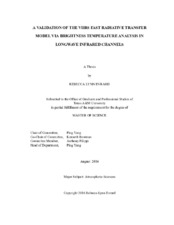| dc.description.abstract | Clouds cover at least two thirds of the Earth at any given time. Clouds play a large role in the Earth’s global energy budget, but the impact of cirrus clouds is still widely questioned and researched. Cirrus clouds reside high in the atmosphere where temperatures are so cold that the cloud particles are comprised of ice crystals rather than water droplets. Gaining a better understanding of ice cloud optical properties and the distribution of cirrus clouds provides an explanation for the contribution of cirrus clouds to the global energy budget.
Using remote sensing techniques in conjunction with radiative transfer models (RTMs), accurate simulations of cirrus clouds can enhance the understanding of the global energy budget as well as improve the use of global climate models. Prior to their use, RTMs must be tested for accuracy and sensitivity to various cloud optical property (COP) pairs. A well validated RTM such as the Line-By-Line Radiative Transfer Model plus the Discrete Ordinates Radiative Transfer Program (LBLRTM + DISORT) is compared to a newer, faster RTM such as the Visible Infrared Imager Radiometer Suite (VIIRS) Fast Radiative Transfer Model (VFRTM). By comparing brightness temperature (BT) simulations from both models, the accuracy of the VFRTM can be obtained. Based on previous studies, a root mean square error (RMSE) < 0.5 K for brightness temperature difference (BTD) analysis is an appropriate level of error. This study shows RMSE < 0.2 K for BTD using reanalysis data for atmospheric profiles rather than idealized profiles and updated ice particle habit information from the Moderate-resolution Imaging Spectroradiometer (MODIS) Collection 6 (C6). At a higher resolution, the simulated results of the VFRTM are compared to the observations of VIIRS to further indicate the accuracy of the model for use on a global scale as well as to validate the use of MODIS C6 data. RMSE results for the given case study represent < 1.5% error from the VFRTM for all cases. The VFRTM is validated and is an appropriate RTM to use for global cloud retrievals to help improve and update the global energy budget and global climate models. | en |


